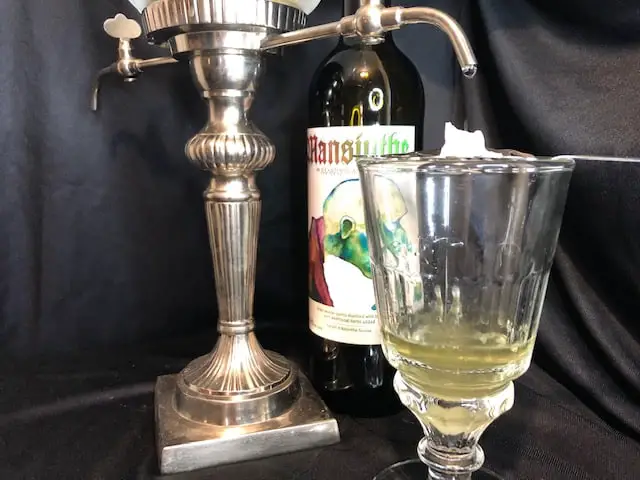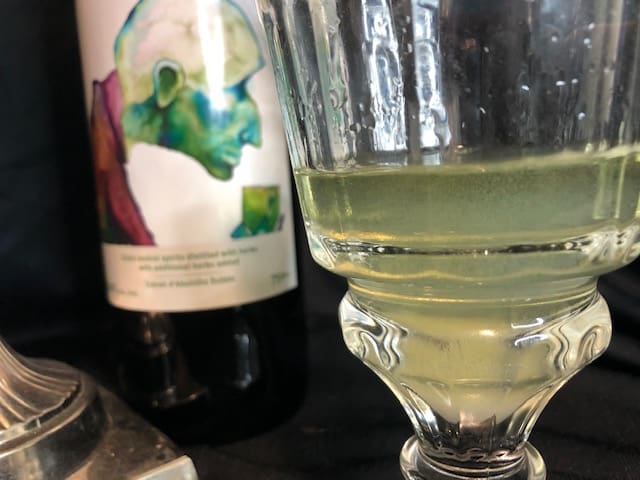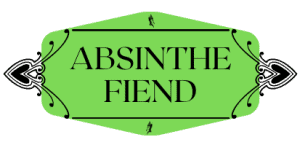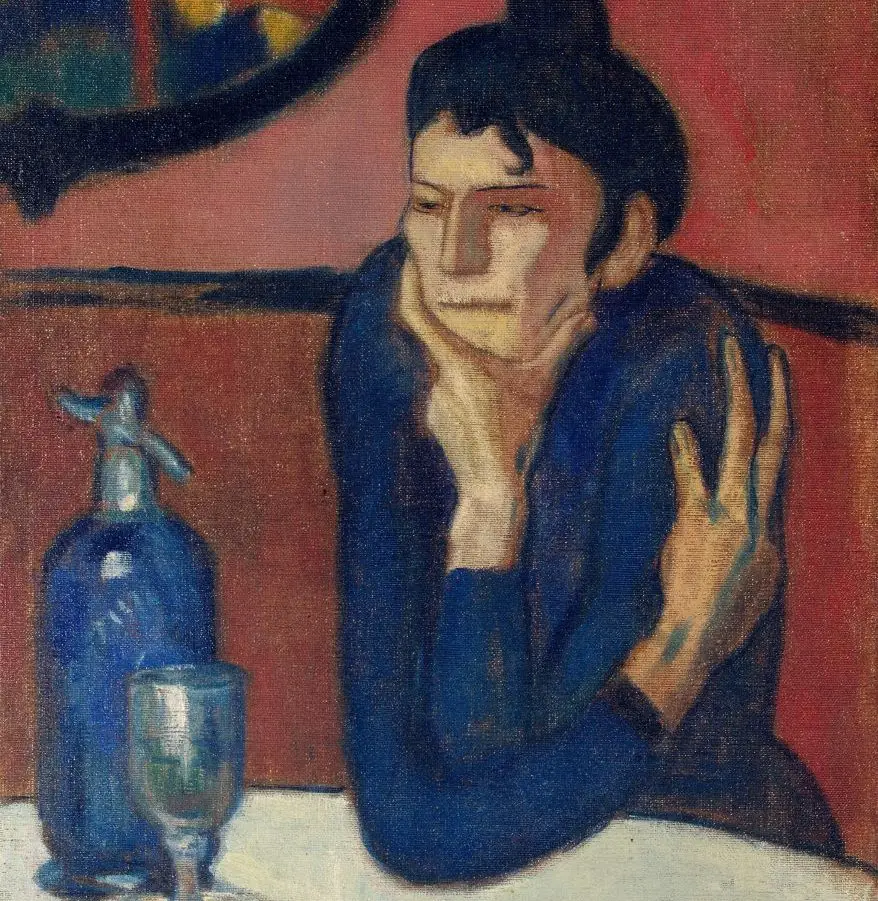Absinthe is a unique spirit that has a complex flavor profile that can be difficult to describe. In order to appreciate all of the flavors and aromas that Absinthe has to offer, it is important to taste it in the proper way.
Fortunately, the process is actually quite simple!
Once you know how to properly savor all of the unique flavors and textures, you’ll gain an even greater appreciation for everything that the Green Fairy has to offer.
In this blog post, we will teach you how to taste Absinthe like a pro!
Choose the Right Absinthe Glass
What glass you prepare absinthe in has a strong effect on the overall experience. As you might have seen, absinthe is traditionally served in a special glass.
While there are many variations of absinthe glasses, they are most commonly designed to hold a specific amount of liquid in a small “bubble” reservoir on the glass’s stem.

This “bubble” serves as a measuring tool that allows you to pour the perfect serving of absinthe.
But it also serves another purpose.
The shape of the absinthe glass is meant to enhance the aromas, flavors, and visual effects as you prepare absinthe.
So while you can technically prepare absinthe in any glass, you’re depriving yourself of a huge amount of absinthe’s real charm if you aren’t using the proper equipment!
Observe the Absinthe’s Color
The next step is to observe the Absinthe’s color and opacity, preferably under neutral lighting.
Absinthe comes in a variety of styles which you can read about here.
The most common is Absinthe Verte which commonly ranges from pale yellowish-green to a deep emerald color.
Since this color comes from the herbs used to make it, don’t worry if there are more hues of brown. It’s natural!
Related: Why Does Absinthe Lose Its Green Color?
You may also find clear absinthe (known as a blanche or bleu) or red absinthe (known as a rouge).
Because the art of distilling absinthe is such a labor of love, it’s important to appreciate each phase of the absinthe as it appears in your glass.

Furthermore, the Absinthe’s color can give you some clues about its flavor profile and the process used to craft it.
A blanche will often have a much lighter flavor than the more herbal verte. Meanwhile, a rouge absinthe will often taste much more floral because of the hibiscus flowers so commonly used to make it.
This step shouldn’t take you more than 5 seconds or so.
Smell the Absinthe
Now we move on to the absinthe’s smell.
Absinthe typically has a strong herbal aroma with notes of anise, fennel, and wormwood. Some people also detect floral or citrusy aromas depending on the Absinthe’s recipe.
Pay close attention to the Absinthe’s smell as it can give you some clues about its flavor.
Look for two distinct aroma layers:
- Primary: This will typically be the “licorice smell” of the anise and fennel as well as a bitter aroma from the wormwood. You might also pick up notes of grapes or brandy depending on what kind of base is used to make the absinthe.
- Secondary: These notes are the undercurrents of the absinthe’s aroma. Common inclusions include other herbs (such as mint and coriander), citrus, floral elements, or even ingredients like chocolate!

Because some absinthes are aged in barrels like wine or whiskey, you might find a third layer of aroma in some absinthes. This layer is typically defined by woody and spicy scents infused by the aging process.
If you’re having trouble detecting the Absinthe’s aroma, try gently swirling it around in your glass to release more of the volatile compounds that contribute to its scent.
This is a great way to start getting familiar with the absinthe’s flavor profile.
As we continue with this process, you’ll see why this initial smell is so important!
Prepare Your Absinthe
To prepare absinthe, you will need to add a sugar cube and water.
The traditional way to do this is to slowly pour cold water over a slotted absinthe spoon placed over the glass.
You’ve no doubt often seen this done with a sugar cube resting on the spoon. Sugar is used to offset the characteristic bitterness of most absinthes, so you can do this if you prefer your absinthe on the sweeter side.

As the water drips through the spoon, it will slowly dilute the Absinthe.
I usually prepare my absinthe with a ratio of 3-4 parts water to 1 part absinthe, but you can adjust it to your taste. If you’re a newer absintheur, a ratio of 4 or 5 parts water to 1 part absinthe might be more appropriate.
Recommended: How to Properly Prepare Absinthe (Beginner Friendly Guide)
Appreciate the Louche
A huge part of the absinthe ritual is watching the changes that occur when the water reacts with the absinthe. You’ll see as the absinthe takes on unique layers and swirls from the oils reacting with the water.
The absinthe will begin to take on a type of pale milky color with brief highlights of green (if it’s a verte) or blue (if it’s a blanche)!
This is called the louche and it’s a great (and hypnotizing) way to appreciate what makes absinthe so unique.

But this effect is more than just something fun to watch!
The louche affects the absinthe’s flavor and aromas by causing certain compounds to become more soluble.
This means that you’ll be able to taste and smell different aspects of the absinthe as the louche occurs.
It’s truly a fascinating process that is definitely worth taking the time to experience.
I know the anticipation is almost too much stand by this point, but go ahead and give it another smell. With most absinthes, you’ll be picking up totally new aromas that you didn’t catch before!

Take a Sip
At last, we have arrived at the best part of the absinthe tasting process!
You’ve taken the time to appreciate and prepare your absinthe thus far. It would be a terrible waste to slam it like a shot of cheap liquor!
No, we’re taking a less barbaric approach to truly explore what the Green Fairy has to offer.
Take a small sip of absinthe and gently roll it around in your mouth. Don’t swish it!
You want to let the flavor interact with the different areas of your palate and explore how the different flavors manifest.
The tongue is able to pick up on flavors that are bitter, sweet, sour, and salty based on different areas.
Related: Foods to Pair With Absinthe!
Because of the presence of bitter herbs like wormwood, this will commonly be the most prominent flavor. It is tempered by the sweetness of sugar (if you used it) and a light sourness from citrus elements in the absinthe.
In addition to the flavors in the absinthe, pay attention to the textures. You should feel the natural oils from within the absinthe coat your tongue and palate.
Think of the combination of aromas, flavors, and textures as a “story” that the absinthe is telling you. As with any story, pay attention to the main point but also be mindful of the nuances and little details that are present.
Take your time with this step. Experience the beginning, mid-palate, and end (or finish) of the “story” being told.

Swallow the Absinthe and Exhale Through Your Nose
This is a vital part of the absinthe tasting process that all too often gets sorely neglected.
As the “story” reaches its conclusion, swallow the absinthe.
Upon swallowing, lightly exhale through your nose. You’ll now be receiving the absinthe’s aromas retro-nasally which can give you an entirely new aroma profile!
You’ll be surprised at the flavors and aromas that you pick up on this way that you didn’t get at first!
This serves the purpose of clearing your palate in preparation for the next sip while also allowing you to enjoy the absinthe’s aftertaste.
Who would have thought that there was so much character to discover in just a single sip?
It’s no wonder absinthe especially enchanted some of the greatest artists and painters of the Belle Epoque!
Write Down Your Thoughts
A spirit as complex as absinthe is impossible to generalize.
There’s an entire world of unique absinthes out there with even more distillers presenting their takes on the Green Fairy. It can be overwhelming!
Even before I began blogging, I found it helpful to keep a small journal with the various absinthes I tried. This gives you a way to compare different absinthes and identify the flavors and aromas that you like.
Consider factors like:
- What stands out about the absinthe to you and makes it unique?
- Did it feel balanced or did one element overpower the others?
- Did you like it?
Not only will you learn more about your own taste preferences, but you’ll even get to see how they change as your palate matures and your horizons broaden!
When I look at absinthes that I loved when I first got into the absinthe world in the late 2000s, I can’t help but laugh.
My palate has changed so much and I’ve developed such a deep appreciation for certain flavor profiles that I might have completely dismissed back then.
Absinthe tasting is truly an adventure, so be sure to enjoy the journey!
Related: Why Is Absinthe Expensive? (It’s Actually Not!)
Conclusion – How To Taste Absinthe Properly
But, alas, we have come to the end of this guide.
I hope this article has helped you understand the proper way to taste absinthe.
Absinthe is a unique spirit that should be enjoyed in the proper way to truly appreciate its complex flavors and aromas.
I’m confident that by following the steps we’ve outlined in this article, you’ll be able to taste absinthe like a pro and better enjoy the world of this fascinating spirit.
Just be sure that you’re also making it a point to store your absinthe properly. Check out this guide to learn how!

